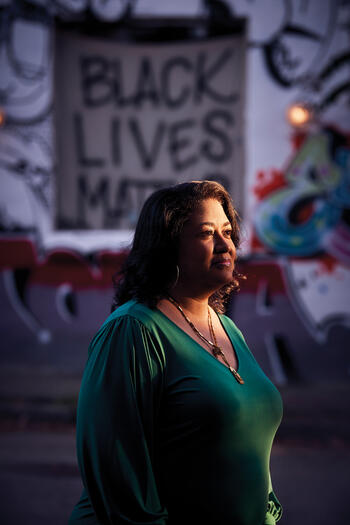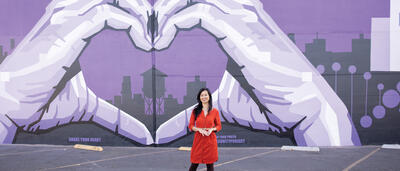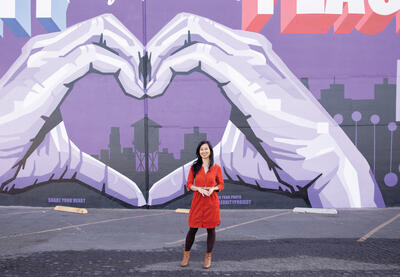As an elementary teacher with a passion for math and an assistant professor of education who specializes, in part, in math education, our paths have crossed because we both believe in the humanizing power of mathematics. Engaging in mathematics education with a humanizing love can allow students to see themselves as complex human beings who are affected by institutionalized racism but not defined by it. As educators, mothers and organizers of color, we make this argument out of radical love for our students and the education community.
In Pedagogy of Freedom: Ethics, Democracy, and Civic Courage, Paulo Freire describes radical love as an “armed love.” In Women, Culture & Politics, Angela Davis argues that radical means “grasping at the root.” In this spirit, we invite you to consider how education, specifically mathematics education, has harmed students and, importantly, how it can also repair that harm. We believe in the power of mathematics to quantify the past and present and to also serve as a tool for liberation.
Math Is Political
Math—including math education—is absolutely political and has been used in violent ways to subjugate, harm and even kill. The use of data science to identify suspects or sentence people to prison has been widely criticized for bias. And the legacy of racist ideologies can be found in the use of data and mathematics today.
For example, the spirometer, a medical tool that measures lung capacity, was once used on plantations to unjustly argue enslaved Black people were most fit for field labor. The tool’s settings, often including a button that “corrects” for race, are still in use today. This is one of many medical tools shaped by anti-Black racism.
In the beginning of the COVID-19 pandemic, we were inundated with charts and graphs of infection data, availability of PPE and statistics on rising xenophobic and racist attacks. The easy action would be to analyze this real-life data with our students in mathematics classes. But data and mathematical models include and exclude information to capture a snippet of the world at a particular time and place. Failure to consider the context, politics and history behind the data is in itself failure.
How can we use math, acknowledge the harm it does and also drive liberation? Educators must spend significant time understanding some basic truths. We must start by acknowledging that we all lead very different racialized lives and that legacies of racism and white privilege permeate our work.
For too many of our students, doing school mathematics consists of sitting silently, using algorithms that are foreign to them and solving problems irrelevant to their interests and experiences. Their knowledge and perspectives are pushed to the margins, leaving them, especially students of color, silenced and misinformed.
As educators of color, even we must unlearn our conditioning to hold space for whiteness. We must recognize the ways math education functions to destroy students’ cultural identities. We must intentionally center folks of color and marginalized voices.
We work daily to bear this out in our lives and pedagogy.
Marian’s Context
I am a Black woman, married to a Black man, with adult Black children. I don’t know much about my ancestors beyond a few tales of great-grandparents. I do know they were enslaved. There is a certain shame about not knowing your true country of origin, not knowing your native tongue. Honestly, there is a certain envy I carry of those who do.
I also know that mathematics is the lens through which I see the world. It’s not something I became; it’s who I have always been. My parents raised me to quantify everything.
My educator mother, who did not describe herself as a math person, would periodically dump the contents of her purse onto the bed to reveal shiny coins of every color. The ongoing challenge? To correctly count it in any way I chose and then present her with my findings. If I could do that successfully, the bounty was mine. In pedagogical language, I had engaged in productive struggle, persevered, made use of structure, modeled with precision, used regularity and constructed my argument.
Did I know I was doing this? Did my mother make sure that I knew those words? Of course not. She knew that the concepts and my ability to connect them to life were what mattered.
Similarly, long sessions at the kitchen table with my dad as he revealed the secrets of numbers and algebra made me believe he was magical. That math was magic. I loved mathematics—it was as natural to me as breathing. My parents both allowed me to emerge confident in my mathematical reasoning.
Is it possible to teach mathematics this way? It is, and I do. The educator in me thinks mathematically. The accepted mathematical canon is full of Eurocentric postulates and formulas. Cathery and I sense, though, that mathematics is far more intuitive.
How Marian humanizes math
For most of my career, I have taught elementary students multiple subjects, yet students past and present refer to me as their math teacher. I carry that title with pride. This mathematical part of my identity, along with my Blackness, informs the reframing of math we’re arguing for.
On a nondescript day, I’m reading aloud to my fourth and fifth graders the picture book The Other Side by Jacqueline Woodson. As children discover a different set of expectations for Black and white characters in the book, symbolized by the fence that separates their properties, I encourage them to dig deeper, relating this story of a time before they were alive to now:

Why did both the white and Black parents want their children not to cross the fence? What was different about their reactions? Who created the fence? Whose job is it to cut it down?
I want them to see the interpersonal biases and the systemic forces that create and maintain the fence. I then direct them to the present and connect it to relevant mathematics:
You have said that the neighborhoods in the book were segregated. Are your neighborhoods segregated today? What about schools? Is this school segregated? Has it ever been?
I bring in pie charts of the school’s current and past racial demographics. Students also analyze historical data of the city’s racial demographics. I ask, “What story are the numbers telling?”
Looking at history through a mathematical lens is a step toward humanizing math. As children learn how to create their own graphs and charts, they can also interrogate how the nexus of history, math and humanity lies in the formation of the question to be answered. Whose story is not being told? What question was not asked? The data is only as good as the questions that birthed it, and if the assumptions under which the questions were formed are biased and racist, then the math is inevitably racist as well.
The lesson using Woodson’s book continues with an analysis of local gentrification—with math at the root.
Cathery’s Context
I am Chinese American, an immigrant and a mother of a child with a disability. These social identities shape who I am and what I see and feel about the world around me. I am exhausted. I can’t sleep. My heart aches. I can’t get the image out of my head: Tou Thao, the Asian American police officer who stood by as Derek Chauvin kneeled on George Floyd’s neck. He stood by in silence, with his hands in his pockets, even as onlookers pointed out that Floyd wasn’t moving, didn’t seem to be breathing and cried out for his mother. Thao remained silent. Indifferent.
Within the Asian American community, I have seen us join our voices in ongoing protests speaking up against anti-Asian xenophobia and racist attacks normalized by a leader who called the current pandemic the “Chinese virus” and the “kung flu.” Yet, too many remain silent in the face of injustice toward Black lives.
Within the mathematics education community that I call home, how often do we speak boldly for justice but actually continue to inflict violence on Black lives?
How Cathery humanizes math
Humanizing mathematics begins with challenging racialized myths about what mathematics is and who can or cannot do mathematics. Mathematics is a human activity tied to languages, histories, lands and culture. As a classroom teacher, I visited over 300 students’ homes while community members and members of grassroots organizations came into my classroom. We taught lessons together centering on the mathematics that takes place within homes and communities—from braiding hair, baking bread, doing carpentry and shopkeeping to examining homelessness, gentrification and affordable housing. These experiences and community-based pedagogies bridged classrooms to community and social movements.
Now, as a teacher educator with future mathematics teachers as students, I use the Teaching Tolerance Social Justice Standards as a road map for humanizing mathematics education. Within my mathematics methods course, I ask my students to develop and implement justice-aligned math lessons that address both a mathematics standard and a social justice standard.
The TT standards offer a way to use mathematics to locate inequities and to look critically at how mathematics is used inside and outside the classroom. For example, data on issues of race in the United States are cast along the lines of Black and white. Asian Americans and other communities of color are intentionally included in statistical models at times and excluded at others when the data perpetuates the model minority myth. Such use of data creates a monolithic identity for Asian Americans and also drives a wedge between communities of color. Mathematics is used to divide.
Attending to the TT Social Justice Standards shifts a math lesson from mere statistical calculations to the development of critical statistical literacy. Do you see yourself represented in the data? Who is included? Who is missing? How do the data display, labels and scales convey a particular message? What is the message? From whose perspective? These questions allow students to see the subjectivity in all text, including mathematical text, and to examine the histories and backgrounds that inform the data.
Naturally, students want to look up and create data displays that honor their social identities, including their membership in multiple groups, as well as honoring their peers. Using this approach, my math education students have had their K-12 students share their own data displays with their peers, the school board, city council and curriculum publishing companies to stand up to exclusion and injustice.
What is missing from mathematics education is the mathematics of solidarity and interracial resistance. Asian American liberation builds on a history of solidarity between the Asian and Black American communities, starting from Frederick Douglass’ denouncement of anti-Chinese laws and continuing to current fights against the racism of the pandemic. When it came to welcoming Asians to the United States, Douglass highlighted the nation’s diversity and used mathematical language to argue for equality: “Only one-fifth of the population of the globe is white,” he argued in 1869, noting that “the other four-fifths are colored and ought to have some weight and influence.”
Let’s use Douglass’ work as an example and create lessons on the mathematics of community organizing. The Third World Liberation Front, the Montgomery Bus Boycott, the formation of the United Farm Workers Movement by Latinx and Filipinx labor workers and the Black Lives Matter movement all started with a few people who mobilized millions. For decades, social justice organizers have modeled nonlinear growth and the fact that our sum is greater than our division. I am inspired by these narratives despite the social and structural inequalities at hand. Our lives are interwoven; our numbers matter. Our liberation is intricately bound together.
The Path Forward
Conflict has always been a central part of mathematical stories, but we need to highlight working together and the day-to-day work of finding solutions to problems. Now, as the United States sees mass uprising against racial injustice and police brutality, we need to center the mathematics of solidarity and challenge the mathematics of division. The way we teach math is key to this shift.
We don’t need to reimagine teaching mathematics for liberation. Mathematics—data, mathematical models and numbers—lives everywhere, especially in our organizing. We need only to look to current and historical moments of strategic, mathematical insurgence against structures of oppression as blueprints for liberatory mathematics education.

Toolkit for “Mathematics in Context: The Pedagogy of Liberation”
This toolkit will help educators consider how to “humanize math” using Learning for Justice’s Social Justice Standards. It provides opportunities for reflection and examples of real-world applications.
